| LIKE THE MORNING MIST,
history lingers in the hills and valleys of Western Massachusetts. In
Shelburne Falls, tangible reminders of this rural community's former
prominence as a regional railroad connection are everywhere in evidence.
From 1896 through 1926, the Shelburne Falls & Colrain Street
Railway was a vital part of this connection, linking communities along
the North River to Shelburne Falls and the railroads.
In the trolley's day, Shelburne Falls was a stop along the Boston & Maine Railroad's main line from Boston to Troy, NY, with through connections via Rotterdam, NY, to Chicago. It was also the northwest terminal on the New Haven Railroad's Northampton division, which shared tracks into Shelburne Falls with the B&M.; Here New Haven trains arrived from and departed for Northampton, Springfield, Hartford, and New Haven.
This late 1920s view of Shelburne Falls Station is looking westbound toward Troy, NY. The trolley line appears to have been taken up. Its tracks came up the hill from beyond and to the right of the station. Bob's Photo, collection of Harry A. Frye. The Falls was a shipping point for this hilltown region's agricultural and manufactured goods, of which milk, apples, and lumber products were dominant. It was also a point where coal, raw materials, and commodities were brought in. The trolley expanded the usefulness of the town's railroad connection by reaching Colrain, eight miles distant, and serving the manufacturing villages of Shattuckville, Griswoldville, and Lyonsville along the way.
This postcard view shows an open car stopped opposite the post office, Red Men's Hall, and H.O. Scott & Son's store in Lyonsville. Collection of Roger E. Somers. THE TROLLEY WAS AT ONCE an integral part of people's daily lives, carrying mail, express packages and newspapers, taking people to and from work, porting children between school and home, and providing basic transportation that previously was only possible by horse and carriage or by walking. The company sponsored summer outdoor band concerts in Colrain and operated Hillside Park in Shattuckville as a picnic grounds and baseball park. The line's two open cars provided pleasurable riding on hot summer days. Saturday nights were shopping nights in Shelburne Falls, and the trolley made them a convenience for people in outlying districts. The line's informal nature was endearing to some - it was known to back up to a previous stop if someone suddenly remembered they had forgotten something at home - and probably frustrating to others when trips were delayed by the need to couple up a freight trailer for hauling goods to another place along the line. Unlike many trolley lines, the SF&C; operated a number of years in the black and even paid dividends for each of the years 1911 through 1917. These particular years were difficult for trolley companies in general, as costs and competition from automobiles, trucks, and improved roads ate into traffic and revenues while increasing expenses. In the years following 1917, post-World War I inflation set in and the line increasingly slipped into the red. It finally quit in 1926 when planned improvements to route 112, along which the trolley ran, would have forced prohibitively expensive track relaying. The line was sold for scrap in 1927 and dismantled in 1928. At the end, Frank Johnson, who owned a farm in East Charlemont, by the intersection of the North and Deerfield Rivers, bought trolley #10. It had been the line's workhorse and only car purchased new at the start of operations. It remained on the Johnson farm until his son, Marshall, donated it to the Shelburne Falls Trolley Museum in 1993. Restored by the museum, #10 returned to operation October 9, 1999 and continues to operate along part of its old haunt at the Buckland Rail Yard on weekends and holidays through the summer and early fall.
Trolley #10 at the Johnson farm in East Charlemont, 3 April 1991. Photo by Alfred Barten.
Original plans called for the trolley line to cross the Deerfield from Shelburne to Buckland by way of the iron highway bridge (which is still in use), then continue up the hill past the railroad depot into the rail yard. There freight could be transferred between the trolley's four-wheel freight trailers and the railroad's larger freight cars. Structural engineers certified the bridge to be capable of supporting the trolleys and trailers, but for no recorded reason the Buckland selectmen refused to permit the trolleys to cross the bridge. As a result, trolley freight arriving or departing by railroad had to be hauled between the rail yard and the Shelburne side of the river by horse and wagon. This meant extra handling and drayage charges. In
1907 the trolley company determined that all the additional drayage and
handling expenses to date would have paid for a trolley bridge. Thus a
charter was granted, plans were drawn, and a five-arched concrete
structure built and placed in service by early 1909. The approximately
200-foot long bridge was designed to withstand the weight of standard
railroad freight cars, making possible full interchange between the rail
lines. Today the bridge stands as the renowned Bridge of Flowers,
centerpiece of Shelburne Falls's tourist attractions. Since the bridge
doubles as an aqueduct, its longevity is assured.
The Bridge of Flowers, 13 June 1999. Photo by Alfred Barten. In addition to
the Bridge of Flowers, visitors to Shelburne Falls enjoy the town's
picturesque setting among the hills along the Deerfield River; the
Victorian architecture built in the latter 19th century as Shelburne
Falls's business developed along with the railroad; natural features
such as Salmon Falls and the prehistoric potholes in the granite below
the falls; and the SF&C;'s only remaining trolley, operating at the
trolley museum.
WITH A LITTLE HELP from the Buckland selectmen in 1896, and many good folks since then, Shelburne Falls' lingering sense of history has helped transform it into a popular place to visit while remaining an attractive place to live and work. The memory of the Shelburne Falls & Colrain Street Railway's lives on in its famous bridge and restored trolley.
Alfred Barten, 12 March 2001.
|
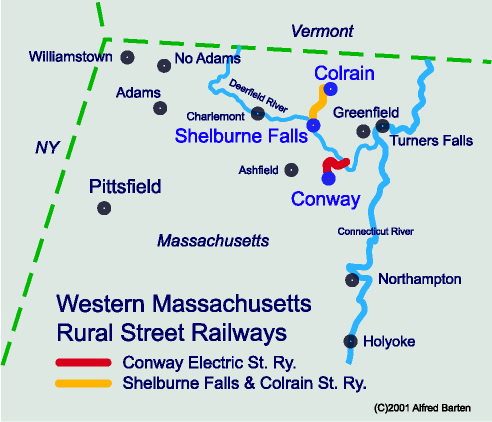
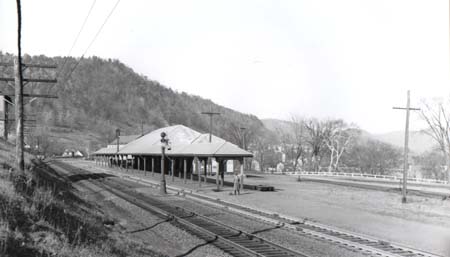
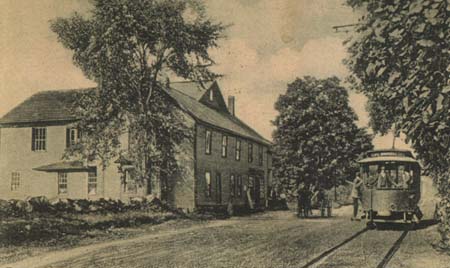
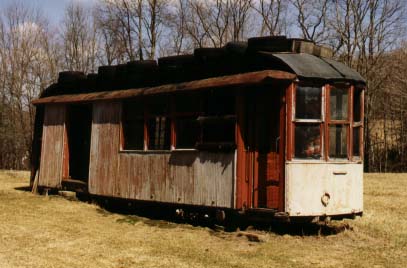
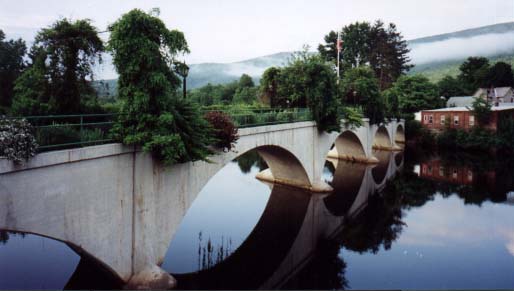
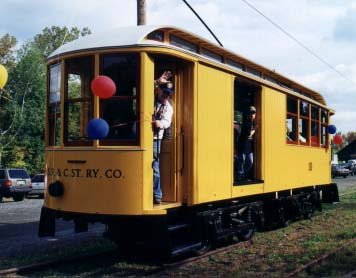 Fully
restored SF&C; #10 is back on track at the Shelburne Falls Trolley
Museum. The date is October 9, 1999, the day of #10's return to
operation after a 73 year layover. Photo by Alfred Barten.
Fully
restored SF&C; #10 is back on track at the Shelburne Falls Trolley
Museum. The date is October 9, 1999, the day of #10's return to
operation after a 73 year layover. Photo by Alfred Barten.